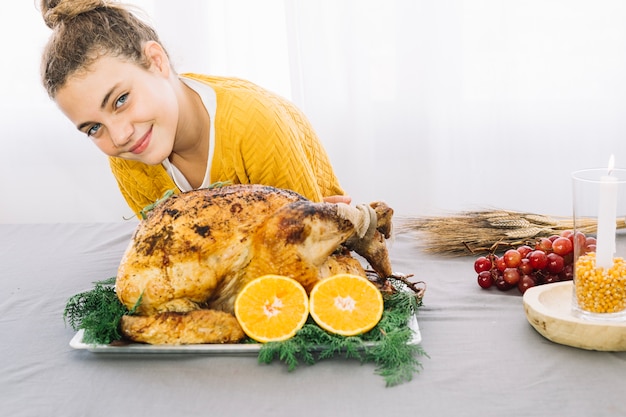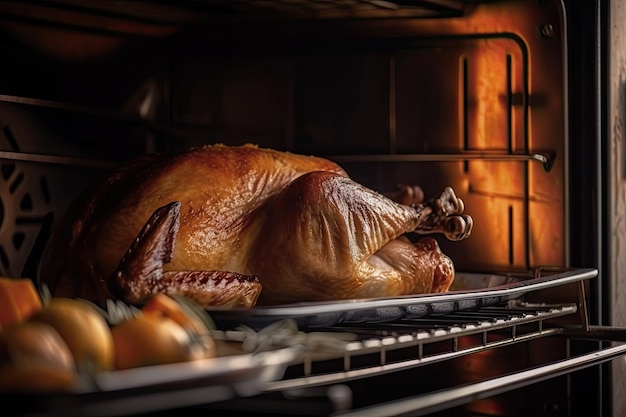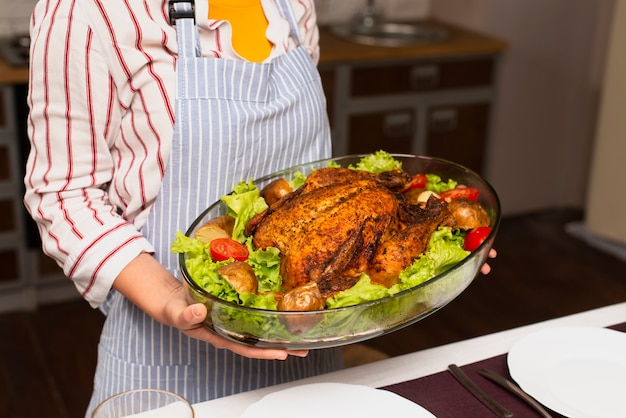You know that feeling when you’re craving a juicy, flavorful chicken dish but a tiny voice in the back of your mind whispers, "Is it safe?" Well, let me tell you, that voice is wise! cooking chicken requires a bit more attention than just tossing it in the pan and hoping for the best. There's a crucial factor that separates a delicious dinner from a potential health hazard: internal temperature.
This article isn't just about the "how-to" of chicken cooking; it's about understanding the "why" behind it. We're going to dive into the science, share real-life experiences, and demystify the process of cooking chicken safely. Think of it as your personal guide to confident and worry-free poultry preparation.
(Part 1) Why safe internal temperature is King

The Enemy Within: Bacteria in Chicken
Chicken, as delicious as it is, can harbor bacteria like Salmonella. These tiny critters are invisible to the naked eye and can cause serious food poisoning. Now, I'm not trying to scare you, but it's essential to understand the potential risks involved. I remember a time when I wasn't as careful and ended up with a nasty case of food poisoning. Let's just say I wasn't cooking for a while after that!
Don't Be Fooled by Appearances
You might think that chicken is safe to eat when it turns a nice golden brown, but you'd be surprised. The colour doesn't always tell the whole story. Bacteria can survive even if the chicken looks cooked, and that's where the internal temperature comes in.
How Internal Temperature Saves the Day
Think of cooking chicken like a battle against these microscopic enemies. The internal temperature is your weapon. When the chicken reaches the right temperature, it effectively eliminates the harmful bacteria, making it safe to eat. It's like a heat shield against foodborne illness.
(Part 2) The Magic Number: Understanding 74°C (165°F)

The Food Standards Agency's Golden Rule
The Food Standards Agency, the UK's leading food safety authority, recommends that chicken be cooked to an internal temperature of 74°C (165°F). This applies to every part of the chicken, from the breast to the thighs and wings. It’s a universal guideline that helps ensure the safest possible outcome.
Why This Temperature Works
This temperature is critical because it's high enough to kill off any harmful bacteria present in the chicken. It's a scientifically determined threshold that ensures the chicken is safe for consumption.
(Part 3) Your Arsenal: Tools for safe chicken cooking

The Essential Tool: A digital meat thermometer
My absolute essential tool for cooking chicken is a digital meat thermometer. It's affordable, easy to use, and provides accurate readings. Forget relying on guesswork, a thermometer gives you the certainty you need. I remember when I first started using one, it felt like a game changer. No more second-guessing!
How to Use a Meat Thermometer
It's simple: insert the thermometer into the thickest part of the chicken, making sure it doesn't touch any bone. Wait for the reading to stabilize and compare it to the safe internal temperature guideline.
Don't Rely Solely on Visual Clues
As I mentioned earlier, visual clues can be deceiving. A juicy, browned chicken might look perfectly cooked, but it could still be harboring harmful bacteria. Always use a thermometer to be certain, especially if you're not experienced with cooking chicken.
(Part 4) Preparing Your Chicken: A Step-by-Step Guide
Choosing the Right Chicken
Start with fresh chicken! Look for a pleasant aroma and a good colour. Avoid any chicken that has an off-colour, a slimy texture, or a strong odour. I always check the sell-by date too, just to be extra cautious. And remember to store your chicken in the refrigerator at 4°C (40°F) or below until you're ready to cook it.
Thawing Safely: Avoid Room Temperature Thawing
Never thaw chicken at room temperature. This is a breeding ground for bacteria. The safest ways to thaw chicken are:
- Refrigerator Thawing: The safest option! It takes longer, but it's the most reliable.
- Cold Water Thawing: Place the chicken in a sealed bag in a bowl of cold water, changing the water every 30 minutes.
- Microwave Thawing: Use a microwave specifically designed for thawing.
The Washing Myth: A Big No-No!
Washing chicken is a common misconception, and it actually increases the risk of spreading bacteria. Washing chicken doesn't kill bacteria; it simply splashes them around your kitchen. Skip the washing step entirely and go straight to cooking!
(Part 5) Cooking Methods: A Variety of Options
Roasting: The Classic
Preheat your oven to 180°C (350°F) and place your chicken on a roasting rack. It takes about an hour to cook, or until the internal temperature hits 74°C (165°F). It's a simple and reliable method for a whole chicken.
Grilling: Summertime Delight
For a smoky flavour, try grilling. Make sure your grill is clean and hot before you start. Cook the chicken over medium heat for about 10-15 minutes per side, or until it reaches the safe internal temperature.
Pan-frying: Quick and Easy
When you're in a hurry, pan-frying is your best friend. Heat some oil in a pan over medium heat and cook the chicken for about 5-7 minutes per side. It's quick, easy, and delicious.
Boiling: Perfect for Soups and Stews
Boiling chicken is ideal for soups and stews. Bring a pot of water to a boil, add the chicken, and simmer for about 15-20 minutes, or until cooked through.
Microwave: For Those Time-Crunched Days
Use a microwave-safe dish and cover the chicken with plastic wrap, leaving a small vent. Microwave on high for about 4-5 minutes per pound, or until it reaches the safe internal temperature.
(Part 6) Understanding Different Chicken Parts
Whole Chicken: The Whole Package
For a whole chicken, roast it at 180°C (350°F) for about 1 hour and 15 minutes, or until the internal temperature reaches 74°C (165°F).
chicken breasts: The Lean Favourite
Chicken breasts are a popular choice for grilling, pan-frying, or roasting. Cook them for about 15-20 minutes, or until the internal temperature reaches 74°C (165°F).
chicken thighs: Juicy and Flavourful
Chicken thighs are known for their juiciness and flavour. They take a bit longer to cook than breasts, about 20-25 minutes, or until the internal temperature reaches 74°C (165°F).
chicken drumsticks: The Grilling Star
Chicken drumsticks are great for grilling or roasting. Cook them for about 30-40 minutes, or until the internal temperature reaches 74°C (165°F). They're also delicious in slow cooker recipes.
chicken wings: A Party Favourite
Chicken wings are perfect for grilling, roasting, or frying. They typically take about 20-25 minutes to cook, or until the internal temperature reaches 74°C (165°F).
(Part 7) Resting Your Chicken: Why It's Worth ItThe Importance of Rest
After you've cooked your chicken, let it rest for about 10 minutes before carving. This allows the juices to redistribute throughout the meat, resulting in a more tender and flavorful chicken. It's a simple step that makes a big difference.
How to Rest Your Chicken
Simply cover the cooked chicken with foil and let it sit on a cutting board or in a warm oven. Resist the urge to carve it immediately, it's worth the wait.
(Part 8) The Danger Zone: A Temperature Range to Avoid
What is the Danger Zone?
The danger zone is the temperature range between 5°C (41°F) and 60°C (140°F). Within this range, bacteria can multiply rapidly. The goal is to keep your chicken outside this zone as much as possible.
Avoiding the Danger Zone
Here are a few simple steps to avoid the danger zone:
- Don't leave cooked chicken out at room temperature for more than 2 hours (or 1 hour if the temperature is above 32°C (90°F)).
- Refrigerate cooked chicken within 2 hours.
- Reheat cooked chicken to an internal temperature of 74°C (165°F) before serving.
(Part 9) Leftovers: Storing and Reheating Safely
Storing Leftover Chicken
Store leftover chicken in the refrigerator in an airtight container and use it within 3-4 days. Freezing is also an option, but use it within 2-3 months.
reheating leftover chicken
When reheating leftover chicken, make sure it reaches 74°C (165°F) internally. Use the microwave, oven, or stovetop to reheat it thoroughly.
(Part 10) A Chicken Cooking Cheat Sheet
To make life easier, here's a table summarizing the safe internal temperatures and cooking times for different chicken parts:
| Chicken Part | Safe Internal Temperature (°C/°F) | Cooking Time |
|---|---|---|
| Whole Chicken | 74°C/165°F | 1 hour 15 minutes |
| Chicken Breast | 74°C/165°F | 15-20 minutes |
| Chicken Thigh | 74°C/165°F | 20-25 minutes |
| Chicken Drumstick | 74°C/165°F | 30-40 minutes |
| Chicken Wing | 74°C/165°F | 20-25 minutes |
(Part 11) FAQs
1. Can I cook chicken to a lower temperature if it's for a specific dish?
No, it's not recommended to cook chicken to a lower temperature than 74°C (165°F), regardless of the dish. This temperature ensures that all harmful bacteria are eliminated.
2. What if I accidentally overcook my chicken?
Overcooked chicken will be dry and tough. While it's still safe to eat, it's not as enjoyable. Try to avoid overcooking in the future.
3. Can I use a meat thermometer to check the temperature of other types of meat?
Absolutely! Meat thermometers are essential for ensuring that all types of meat are cooked to a safe internal temperature. Just use the recommended temperature guidelines for the specific type of meat.
4. How long can I leave cooked chicken out at room temperature before it's unsafe to eat?
It's best to refrigerate cooked chicken within 2 hours. If the temperature is above 32°C (90°F), refrigerate it within 1 hour.
5. What are some good ways to tell if chicken is spoiled?
Spoiled chicken will have a sour or unpleasant odour, a slimy texture, and may have an off-colour. Discard any chicken that looks or smells suspicious.
(Part 12) Conclusion
There you have it! A comprehensive guide to safe and delicious chicken cooking. Remember, the key to enjoying chicken without worries is to prioritize safety. So, invest in a meat thermometer, follow the guidelines, and enjoy a tasty and worry-free meal. Now, if you'll excuse me, I think I'll head to the kitchen and whip up a batch of those juicy chicken drumsticks I've been telling you about!
Everyone is watching

Corn on the Cob: The Ultimate Guide to Perfectly Cooked Ears
Healthy MealsAh, corn on the cob. Just the name evokes images of sunny days, barbecues, and that sweet, juicy flavour that ...

Perfect Pork Roast Oven Cooking Time: A Guide to Delicious Results
Healthy MealsThere's something truly satisfying about a perfectly roasted pork. The aroma alone is enough to make your mout...

Ham Cooking Time: How Long to Bake, Smoke, or Boil a Delicious Ham
Healthy MealsAh, ham. It's a classic, isn't it? A real crowd-pleaser, especially around holidays. And when done right, it'...

Scallops: The Ultimate Guide to Perfect Cooking
Healthy MealsAh, scallops. Those delicate, sweet, and utterly delicious morsels of the sea. They hold a special place in my...

Spaghetti Squash: The Ultimate Guide to Cooking and Serving
Healthy MealsRemember that time you saw spaghetti squash at the supermarket, looking all bumpy and strange, and thought, "W...
